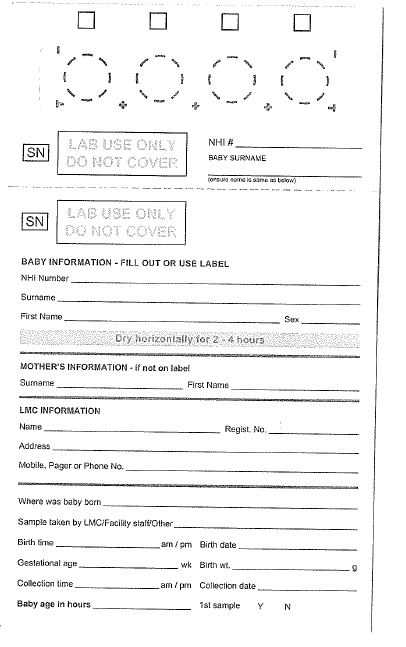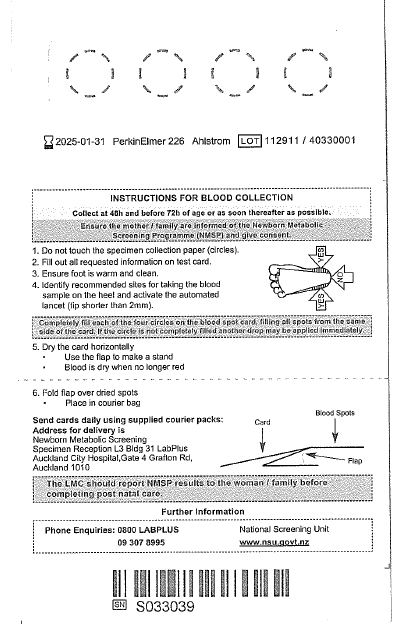



Paul Jones
[FYI request #20835 email]
Tēnā koe Paul,
Your Official Information Act request, reference H2022014520:
Thank you for your email of 12 October 2022 requesting information regarding documentation relating to
to newborn babies. As part of the health and disability system reforms, as of 1 July 2022 the functions
previously under the Manatū Hauora National Screening Unit have transferred to Te Whatu Ora Health
New Zealand (Te Whatu Ora).
As the matters you have raised now fall under the functions of Te Whatu Ora, our agency will respond to
your request which has been considered under the Official Information Act 1982 (the Act). You requested
the following:
“provide documentation on the systems and processes related to handling of a newly born child.
We are particularly interested in the details surrounding the taking of blood and ink print of the sole
of the child's feet. In addition, please also provide samples of the forms used during these procedures
and where they are sent too for processing.”
Guidance related to the care of the mother and newborn in the first few hours after the birth can be found
at
: Observation of Mother and Baby in the Immediate Postnatal Period: Consensus statements guiding
practice | Ministry of Health NZ. However, the newborn metabolic blood spot screen is not taken until at
least 24 hours after the baby has been born so this is not captured in the guidance.
The National Screening Unit (NSU) at Te Whatu Ora has provided information on the systems and processes
related to taking the newborn metabolic blood spot sample from the baby’s feet for the purposes of
Newborn Metabolic Screening Programme (NMSP). The NSU has also provided the forms / blood spot cards
and where they are sent for processing. The NSU provides guidance for all practitioners involved in aspects
of the NMSP including for; Lead Maternity Carers (LMC's), hospital midwives, nurses and phlebotomists.
The guidance available includes:
• Guidelines for practitioners providing services within the NMSP in New Zealand. Please note that
these guidelines are currently being reviewed and are publicly available at:
www.nsu.govt.nz/health-professionals/newborn-metabolic-screening-programme/procedures-
guidelines-and-reports.
• Two e-learning modules for Newborn Metabolic Screening Programme:
1.
Newborn Metabolic Screening Programme.
2.
Best Practice - Newborn Metabolic Blood Spot Collection.
These are publicly available on Learn Online at:
https://learnonline.health.nz/admin/tool/sitepolicy/userpolicy.php. You will need to log onto Learn
Online to view and complete the e-learning modules.
TeWhatuOra.govt.nz
83 Molesworth Street, PO Box 5013
Wellington New Zealand 6140



• The Newborn Metabolic Screening Programme Policy Framework which is publicly available at:
www.nsu.govt.nz/health-professionals/newborn-metabolic-screening-programme/procedures-
guidelines-and-reports/quality.
Additional information on the programme is available at: www.nsu.govt.nz/health-
professionals/newborn-metabolic-screening-programme/procedures-guidelines-and-reports and
www.nsu.govt.nz/pregnancy-newborn-screening/newborn-metabolic-screening-programme-heel-
prick-test/about-newborn.
Hospital or birthing facilities may also have their own detailed practices and procedures for
newborn metabolic blood spot collection that build on the guidance provided by the NSU.
Blood spot cards are sent to LabPLUS, Auckland City Hospital via courier. Prepaid and prelabelled
courier envelopes are supplied to LMCs and hospital and birthing facilities by LabPLUS.
Front of blood spot collection card:
Back of Blood spot collection card:
Note: this picture is slightly different to the example in the Guidelines as the blood spot collection
card has recently been updated.
Taking an ink print of the sole of a child's feet is not part of standard maternity care in New Zealand.
Because of this we are unable to provide the information regarding details of ink print of the sole of the
child's feet and the forms used during these procedures and where they are sent for processing. This part
of your request is refused under section 18(g)(i) of the Act as the requested information is not held by Te
Whatu Ora or Manatū Hauora, or any other agency subject to the Act.


I trust the information provided is of assistance. You are advised of your right to also raise any
concerns with the Office of the Ombudsman. Information about how to do this is available at:
www.ombudsman.parliament.nz or by phoning 0800 802 602.
Nāku iti noa, nā
Stephanie Chapman
Kaiwhakahaere Roopu | Group Manager National Screening Unit National Public Health Service








